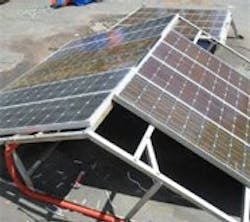Automate Solar for More W/$
The ultimate measure of solar module efficiency is measured by the price you pay for a number of kilowatt-hours of energy production. A panel's efficiency rating—whether it's 8% or 20%—contributes to the final assessment, but also important is the efficiency of the production process used to make the panel. Getting fab costs down lowers the cost/kWh, as do balance of system (BOS) costs, installation efficiencies, and others.
Schiller Automation got its start in the photovoltaics (PV) industry through a-Si technology, which grows thin amorphous silicon films on large panels of glass. There was a time when people thought such thin-film technologies would take over the solar industry from the dominant crystalline silicon (c-Si) methods because thin-film PV uses far less of the expensive silicon material and was cheaper to produce. But crystalline technologies maintained control of the market with falling polycrystalline prices and more efficient manufacturing methods, in addition to already-higher conversion efficiencies.
Although thin-film manufacturing—a-Si as well as copper indium gallium selenide (CIGS), cadmium telluride (CdTe) and other thin-film methods—has been inherently automated, the frontier is still relatively open for c-Si manufacturing in emerging markets. Asian-based crystalline lines have grown very rapidly in both numbers and megawatts of output, and now dominate the market. This growth has been mostly through manual manufacturing techniques. However, the primary demand center remains Europe, and these customers demand the higher quality achieved in an automated process. Tier 1 companies have been automating key processes such as stringing and laminating for some time; increasingly, junction box application and framing are targeted, but there are many more opportunities ahead. And, unlike the thin-film industry, where a solar company's strengths lie in how it differentiates its technology, the c-Si industry is much more standardized, primarily looking for ways to lower costs. Machine builders have opportunities to develop solutions with specific customers in mind, but then spread that solution easily across the industry.
This is not to say that we've stopped developing solutions for the thin-film PV industry. By no means is thin-film going away; it's just no longer taking over. We began by automating front-end production for a leading a-Si turnkey manufacturer, and over time, with 12 or so PV fabs now online, we have played an increasing role in each successive fab.
Amorphous silicon has perhaps the most complex architecture of the thin-film techniques from an automation standpoint. There is more batch processing than linear, with the glass substrate moving back and forth between process tools, which requires a whole lot of logistics tracking. There are millions of substrates being processed each year, and zero people anywhere in what is a huge part of the fab—the front end, where the cells are processed. Having the machine logistics worked out for a-Si processing makes it relatively easy to translate technologies to the back end (module production) and to other thin-film processes such as CIGS and CdTe. And thin film is very active in the U.S. (First Solar, based in Tempe, Ariz., leads solar module shipments with its CdTe technology).
Looking ahead, it is clear that automation and logistics will play an increasing role in solar production. The entire market is growing rapidly. A new market in thin film using CIGS is only just emerging and, like all thin-film technologies, will require advanced automation. Although there is plenty of potential for solar around the world, the demand is predominantly still in Europe and North America. Solar is no longer a cottage industry—it has matured quickly and is growing. As such, key process enablers will play an ever more critical role in the key metric—solar modules with a long life and high quality that meet the low costs required by investors.
Mark Willingham is managing director of Schiller LLC (www.schiller-llc.com) in Westborough, Mass., the solar subsidiary of Schiller Automation in Sonnenbühl, Germany.


